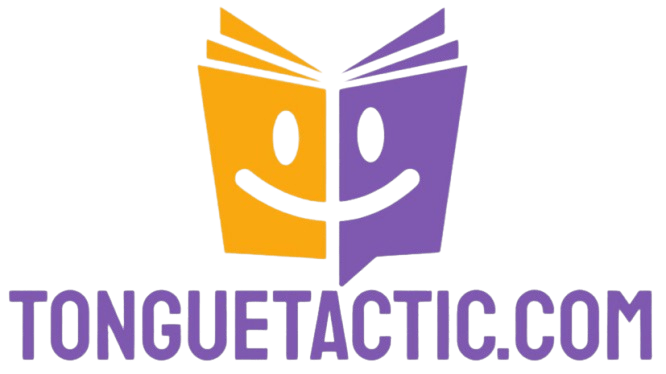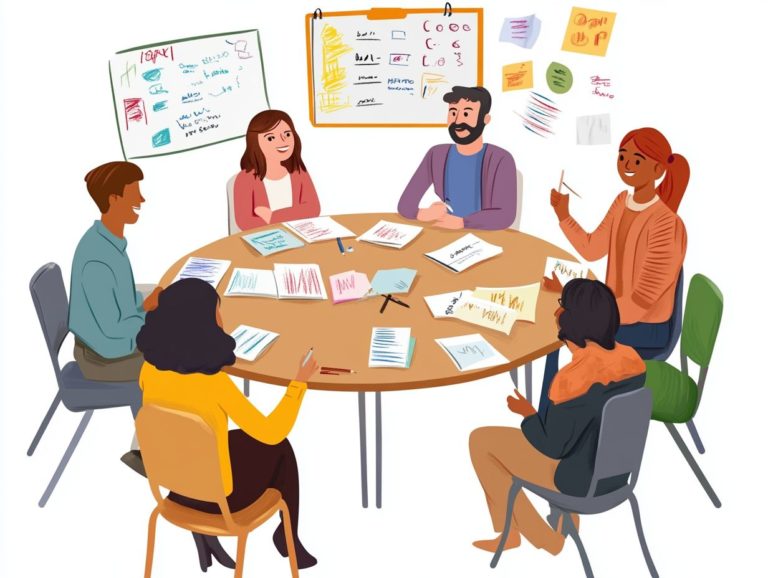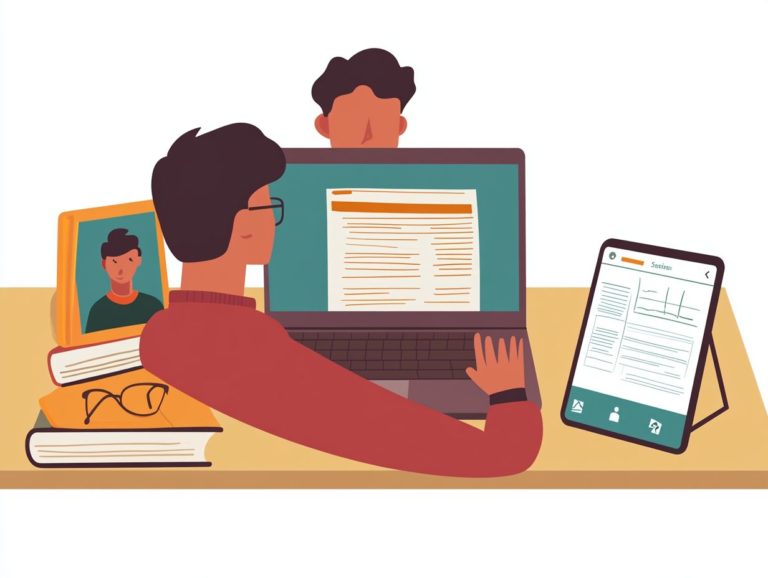the power of visualization in language learning
Visualization stands out as a powerful tool in language learning. It can transform your approach to acquiring new languages.
Integrating visuals into your study routine enhances your memory and comprehension. This makes even complex concepts easier to digest.
This article explores the many benefits of visualization, from enhancing pronunciation to boosting fluency.
It also offers practical techniques for incorporating visuals into your language studies while tackling common challenges you might face.
Unlock your full language learning potential! Harmonize visuals with effective methods now!
Contents
- Key Takeaways:
- The Role of Visualization in Language Learning
- Benefits of Visualizing in Language Learning
- How to Incorporate Visualization in Language Learning
- Overcoming Challenges in Visualizing for Language Learning
- Maximizing the Power of Visualization in Language Learning
- Preguntas Frecuentes
- Cu l es el poder de la visualizaci n en el aprendizaje de idiomas?
- C mo ayuda la visualizaci n en el aprendizaje de idiomas?
- Se puede usar la visualizaci n para todos los idiomas?
- Cu les son algunas estrategias para incorporar la visualizaci n en el aprendizaje de idiomas?
- C mo se puede combinar el poder de la visualizaci n con otras t cnicas de aprendizaje de idiomas?
- Cu les son los beneficios de utilizar la visualizaci n en el aprendizaje de idiomas?
Key Takeaways:

Visualization can greatly enhance memory and comprehension in language learning.
Incorporating visualization techniques can improve pronunciation and fluency.
Combining visuals with other learning methods maximizes the power of visualization in language learning.
The Role of Visualization in Language Learning
The role of visualization in language learning is essential for enhancing engagement and comprehension.
Visual aids like diagrams, mind maps, and multimedia presentations help you grasp complex concepts more effectively.
Using visualization techniques allows you to create mental images that reinforce vocabulary retention. This strengthens the neural pathways crucial for mastering a second language.
Educational psychology highlights how custom teaching methods cater to various learning styles, maximizing your effective learning outcomes.
Understanding the Impact of Visuals on Learning
The impact of visuals on learning is significant. Visual processing plays a crucial role in how you engage with visual information during the comprehension process.
By integrating diagrams, infographics, and charts, you can transform dense textual content into digestible formats for diverse learning styles. For instance, a complex scientific concept can be clarified with a well-designed visual representation, enhancing your retention and recall.
Visual aids improve your reading strategies by breaking down information into manageable segments. This is especially beneficial for kinesthetic learners, who thrive on hands-on activities.
Auditory learners can also benefit from visuals combined with verbal explanations. This combination reinforces understanding through multiple channels, enriching your learning experience.
The strategic use of visuals supports different learning styles and fosters a deeper comprehension of the material you engage with.
Benefits of Visualizing in Language Learning
The benefits of visualizing in language learning go beyond just remembering vocabulary. It boosts motivation, enhances memory, and improves comprehension elements vital for effective learning.
Enhancing Memory and Comprehension

Enhancing your memory and comprehension through visualization techniques means harnessing visual memory and mental rehearsal. This solidifies your understanding during the reading process, aids in retaining information, and transforms abstract concepts into vivid images.
Techniques like mind mapping empower you to draw connections between ideas. Diagramming helps clarify complex relationships in texts. For example, when studying a historical event, you might create a timeline to visually represent causes and effects, making the material more memorable.
Using imagery to depict scenes or characters from literature fosters deeper engagement. This allows you to immerse yourself fully in the narrative. Practicing visualization builds robust mental frameworks that enhance long-term retention and deepen your understanding of challenging material.
Improving Pronunciation and Fluency
Improving your pronunciation and fluency is essential. You can effectively achieve this by leveraging visual aids and immersive environments.
Incorporate diagrams that show mouth movements and charts illustrating stress patterns. Videos of native speakers can help you visualize pronunciation intricacies.
Picture yourself in an immersive virtual classroom! Here, animated characters model correct speech patterns and provide real-time feedback.
Strategies like role-playing in simulated environments let you practice speaking in context. This approach significantly boosts your fluency.
Using visual timelines helps you understand the rhythm of the language. This makes your learning experience both engaging and rewarding.
How to Incorporate Visualization in Language Learning
Incorporating visualization into your language learning journey means using various techniques as effective teaching tools.
These methods enhance engagement and deepen understanding, making your learning experience richer and more effective.
Visual Techniques: Make Learning Fun!
Using tools like mind maps and visual summaries can elevate your language learning experience. These visuals enhance comprehension and retention.
Mind maps let you connect ideas naturally. This creates a richer relationship with the material.
Visual summaries break down content into key concepts, making recall easier during assessments.
Diagrammatic learning adds a spatial element, allowing for engagement on multiple sensory levels.
Integrate these techniques into your study routine to significantly boost retention and application of the language.
Overcoming Challenges in Visualizing for Language Learning

Overcoming challenges in visualizing is crucial for effective understanding. Navigating complex concepts can make visual processing difficult.
Embrace innovative strategies to enhance your learning experience and support deeper comprehension.
Tips for Dealing with Difficult Concepts
Making sense of challenging concepts can be easier with tailored strategies. Use visual aids to help clarify complex grammatical rules.
Diagrams or infographics transform difficult ideas into easy-to-understand visuals. This makes the information more relatable and memorable.
Flashcards enhance vocabulary retention and engage different learning styles. They reinforce connections between words and their meanings.
Tools like mind maps help visualize relationships between concepts, promoting deeper understanding.
By using these strategies, you can make tough subjects more approachable, leading to greater language proficiency.
Maximizing the Power of Visualization in Language Learning
To harness visualization’s power, blend techniques that promote effective learning and engagement. Multimedia presentations and interactive experiences create an inspiring environment.
Combining Visuals with Other Learning Methods
Combining visuals with other learning methods is a powerful strategy for enhancing thinking skills and fostering deeper engagement in your language learning journey.
By integrating auditory techniques like listening to immersive dialogues or participating in interactive discussions you enrich your understanding and retention of new concepts.
Incorporating kinesthetic activities, such as role-playing or using gestures, solidifies your knowledge by activating motor skills alongside cognitive functions.
This approach makes learning fun and effective for everyone! It meets different learning styles directly, cultivating a vibrant, engaging classroom atmosphere.
As you interact through various styles, you re more likely to absorb and internalize information, making your learning experience both meaningful and enjoyable.
Preguntas Frecuentes

Cu l es el poder de la visualizaci n en el aprendizaje de idiomas?
El poder de la visualizaci n en el aprendizaje de idiomas se refiere a la t cnica de utilizar la imaginaci n mental y la visualizaci n creativa para mejorar el proceso de aprendizaje. Implica crear una imagen mental de palabras, reglas gramaticales o conceptos para ayudar en la memorizaci n y la comprensi n.
C mo ayuda la visualizaci n en el aprendizaje de idiomas?
La visualizaci n hace que el proceso de aprendizaje sea m s atractivo y memorable. Permite a los estudiantes crear im genes mentales v vidas de nuevo vocabulario y estructuras gramaticales, facilitando su recuerdo y uso en situaciones de la vida real.
Se puede usar la visualizaci n para todos los idiomas?
S , la visualizaci n se puede utilizar para todos los idiomas. Es una t cnica universal que se puede aplicar a cualquier idioma, independientemente de su complejidad u origen.
Cu les son algunas estrategias para incorporar la visualizaci n en el aprendizaje de idiomas?
Existen varias estrategias para incorporar la visualizaci n, como crear tarjetas de memoria con im genes, dibujar mapas mentales o visualizar oraciones y di logos en tu mente. Tambi n puedes ver videos o escuchar canciones en el idioma objetivo y visualizar las palabras y frases que se utilizan.
C mo se puede combinar el poder de la visualizaci n con otras t cnicas de aprendizaje de idiomas?
El poder de la visualizaci n se puede combinar con otras t cnicas de aprendizaje, como la repetici n, la escucha activa y la pr ctica de conversaci n. Por ejemplo, puedes visualizar una conversaci n en tu cabeza y luego practicarla en voz alta para reforzar tu memoria de las palabras y frases.
Cu les son los beneficios de utilizar la visualizaci n en el aprendizaje de idiomas?
Los beneficios de utilizar la visualizaci n incluyen una mejor retenci n de memoria, una comprensi n mejorada de la gram tica y vocabulario, y un aumento de la motivaci n y el compromiso. Tambi n puede ayudar a aumentar la confianza en el uso del idioma en situaciones de la vida real.






